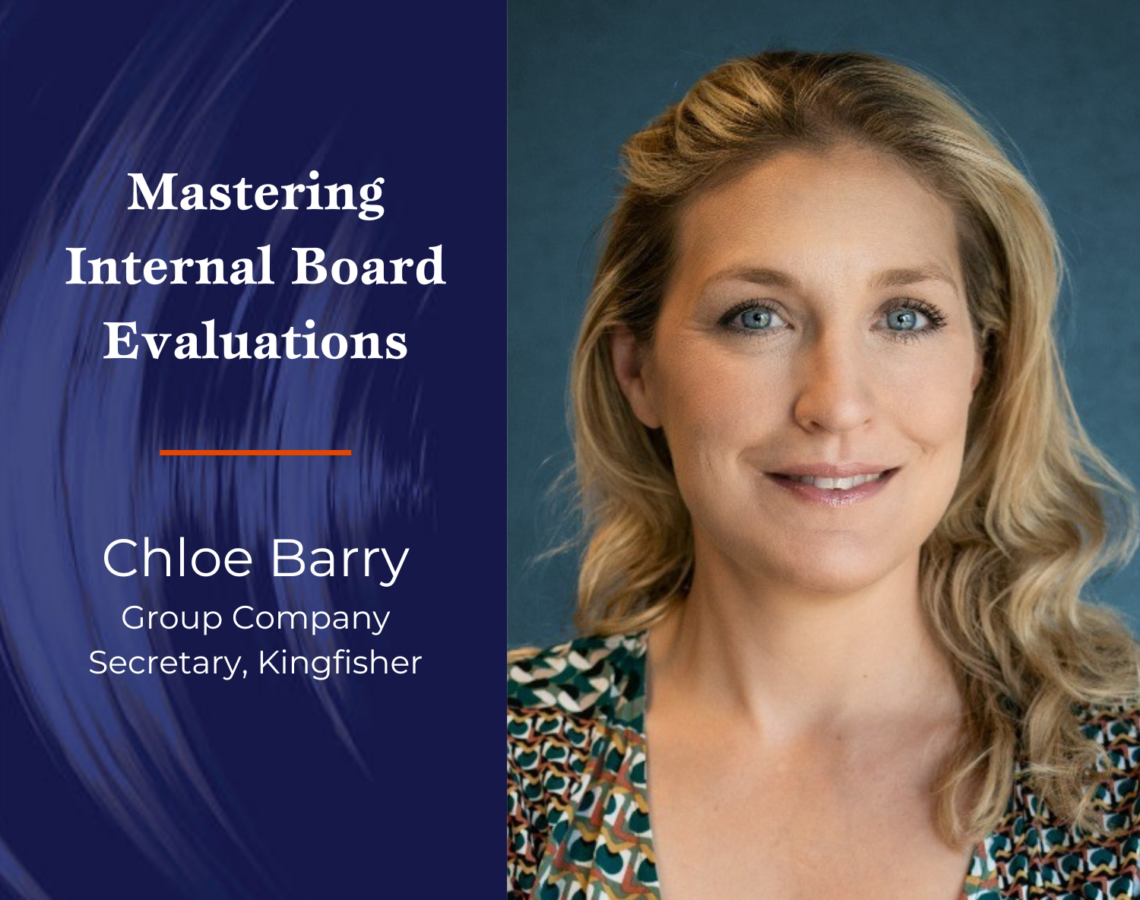Mastering Internal Board Evaluation

Corporate Governance Codes worldwide state that an internal board evaluation shall be conducted in years one and two after a fully facilitated external evaluation. It is one of those tasks on a Company Secretariat’s calendar that has to be done. But how?
In this podcast, Dr Sabine Dembkowski, Founder and Managing Partner of Better Boards, discusses mastering internal board evaluation with Chloe Barry. Chloe is Group Company Secretary at Kingfisher, an FTSE100 organisation and owner of B&Q and Screwfix, among other DIY brands. Chloe started her company secretarial career at PWC in both London and Jersey and since then has held roles at leading FTSE 100 companies, including BG Group up to its acquisition by Royal Dutch Shell, Centrica, Intercontinental Hotels Group and Electrocomponents, and most recently Sophos Group plc, a FTSE 250 company.
“I’m fortunate to have moved from one engaged chair to another”
Chloe starts by explaining her board evaluation process, with the next one planned for the autumn, which will be conducted internally. She outlined how this is notable for two reasons: it is the first led by the new board chair, appointed in June, who has been a board member for nearly six years. Chloe is excited to work with them on what she is certain is a robust process. Secondly, they will use most of last year’s question set, allowing them to measure progress compared to the previous year clearly. To stay focused on identified actions, they intend to introduce a new, short section at the end to measure performance against them.
“We want the directors to leave the process feeling assured that they have identified the appropriate actions”
Board evaluations can be seen as unnecessary and time-consuming, Chloe admits, especially for large boards or those with many committees. However, her experience with engaged boards and directors shows they often do appreciate the process. Despite the time it takes, directors recognise that meaningful participation enhances the quality of subsequent reporting and discussions, and by engaging honestly, sharing views on potential obstacles can significantly improve board effectiveness. In her opinion, a good evaluation process is measured by the practical actions it identifies for improvement. It provides a valuable gauge of director sentiment and engagement for chairs, helping assess board effectiveness compared to the previous year. The process also allows directors to review the past year and give feedback, with reporting allowing detailed reflection on influencing factors. She believes that directors, often experienced with multiple evaluations, need reports that are insightful, easy to digest, and highlight key trends and themes, ensuring they identify actions that will enhance board effectiveness.
“Perhaps counterintuitively, my starting point is always to look back and reflect on the previous few years’ reviews”
To prepare for an internal evaluation, Chloe explains that she starts by reflecting on past reviews, considering the format, tone, actions set in the previous year, and feedback from directors. She also accounts for any immediate changes that have occurred. This helps her decide on the type of review to propose, whether internal or external and if it aligns with their three-year cycle. She considers if the approach should change, for example, whether it needs to be lighter, more targeted, or consistent for comparison. If changing the mechanism or provider, she will always create a shortlist, benchmark with peers, and possibly conduct a full tender. She explains that while board evaluations, particularly internal ones, can take almost any form – verbal, paper or online – the most important thing is to ensure that you are evolving and improving in all respects, both in the overall board effectiveness and individual director experience.
“You need to be honest with your chair”
Chloe emphasises that honesty with your chair about past successes and areas for improvement is essential when making proposals. Also, communication is vital, especially when introducing new approaches or platforms. She relates that she introduced Better Boards for their interim evaluation to focus on peer reviews last year, given the directors’ established relationships. Considerations included various factors such as the new platform, question set, reporting format, timetable, and communication plan. They communicated early with directors and allowed more time for the evaluation to ensure they could acclimatise and engage with the process. In her regular company secretary reports to the board, she included details about the proposed timetable and structure for the upcoming board effectiveness review. She informed them about the new platform, the change of tone, and the increasing focus on peer reviews. She reassured them they had added extra time to the timetable to familiarise themselves with the platform and complete the surveys. The most positive feedback from last year’s review was about the insightful peer review section. She stresses that while it means that directors have to invest a bit more time, it offers personalised feedback from respected peers compared to their self-assessments. This can be empowering, revealing strengths directors might not have recognised. The peer review tool is powerful, allowing measurement of progress with the same questions annually or tailoring to focus on current board priorities. Combining both approaches can be incredibly effective.
The three top takeaways from our conversation are:
- Learn from past evaluations by reviewing agreed actions, feedback, and the process. Show directors you are improving the experience to maintain their engagement. Build in sufficient time and be prepared to adapt. With the chair, agree on the tone, provider, question set, timetable, communication plan, and reporting.
- Inform and engage individual directors early about the process and any new provider, and ensure they complete the evaluation.
- Test the survey, whether homegrown or external and ask others to do the same. This checks for clarity, insightfulness, and practical usability, ensuring the platform works well with your company’s technology. A thoughtful process leads to more engaged directors and valuable insights.
Remember to subscribe and never miss an episode of the Better Boards Podcast Series. It’s available on Apple, Spotify, or Google.
To find out how you can participate in the Better Boards Podcast Series or for more information on Better Boards’ solutions, please email us at info@better-boards.com.



